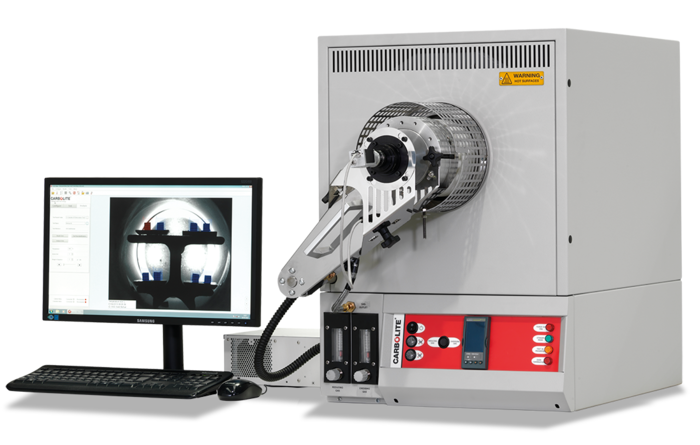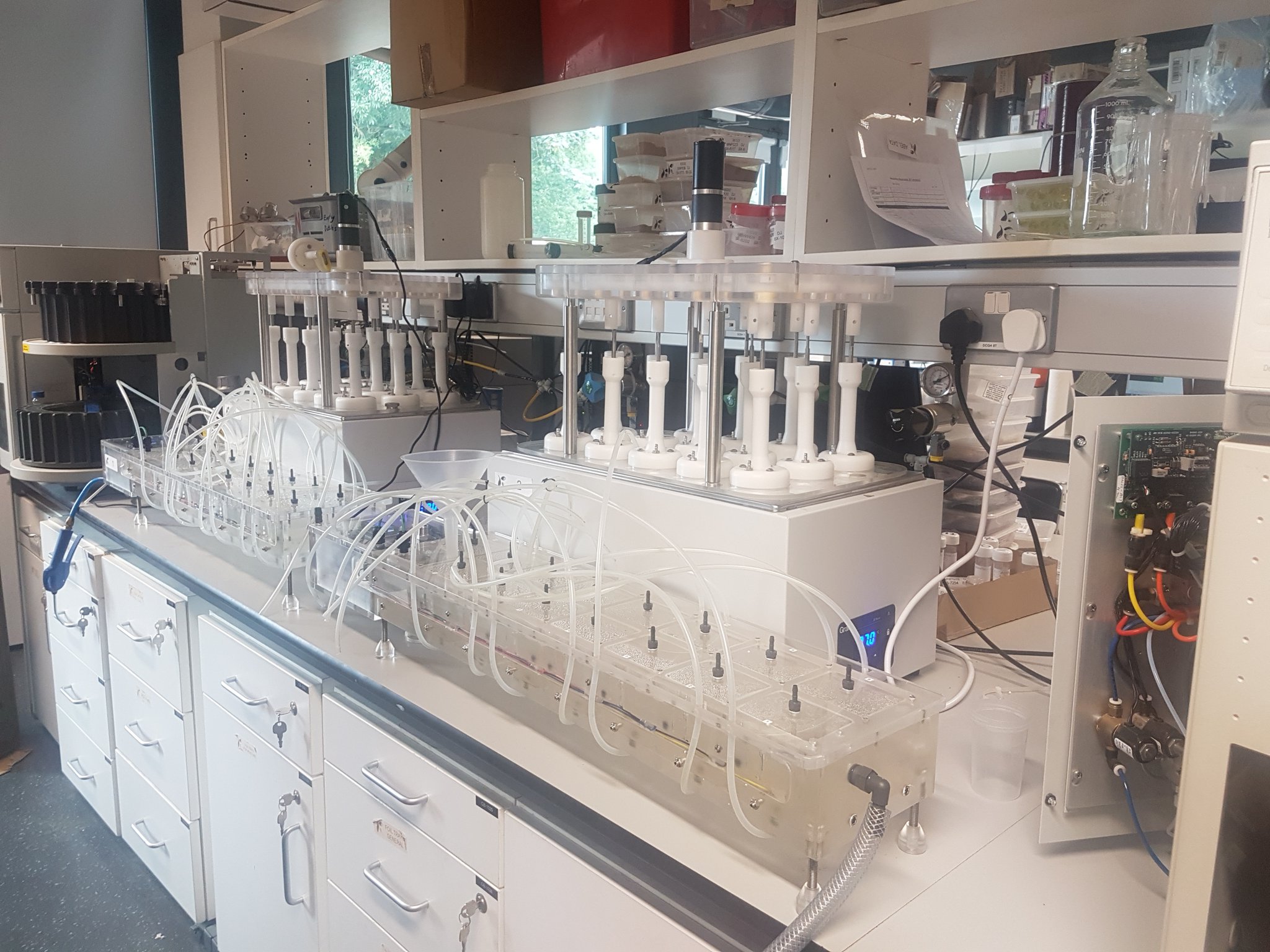Equipment Ion Chromatography
Background
Ion chromatography (IC) is a type of liquid chromatography; the sample is introduced to the system as a liquid, the mobile phase is liquid and the stationary phase is a solid material. In IC, separation occurs due to differing coulombic (ionic) interactions between analyte molecules and the stationary phase. These interactions involve the reversible adsorption of charged solute molecules to the immobilised ion exchange groups of opposite charge on the stationary phase. IC can be termed HPAEC (anion exchange chromatography) when anions are to be resolved and HPCEC (cation exchange chromatography) when cations are analysed. Hence, the stationary phase has ionic functional groups R-X, where X is a cation (X+) in HPAEC and an anion (X-) in HPCEC. This X is associated with mobile counterions that can be reversibly exchanged with other ions of the same charge without altering the matrix. For example, anionic carbohydrates that are held on the ion exchange sites can be replaced with the hydroxide ions of the mobile phase. X can be different groups with different ion exchange capabilities and the total number of charged groups will determine the capacity of the column.
Specifications of Our Ion Chromatography System
We have strong expertise in the use of ion chromatography and in the development of IC methods for the analysis of products relevant to the biomass and biofuels sectors. In particular, we are able to analyse a wide variety of carbohydrates and their degradation products using our system. We use a DIonex ICS-3000 system in our lab, specifications of this system and its current uses are described below:
Modules
- ICS-3000 DC Module (x2)
- Quaternary Gradient Pumps (x4)
- Autosamplers (x3)
- Eluent Generator
Detectors
- Electrochemical (PAD) (x2)
- Conductivity (x2)
- UV-Vis Diode Array Spectrophotometer
Applications
- Monosaccharide Analysis
- Oligosaccharide Analysis
- Analysis of uronic acids and anhydrosugars.
- Carbohydrates in bio-oil water extracts.
- Sugar degradation products (e.g. furans and organic acids).
- Chlorine and other ions in biomass.
Ion Chromatography for Carbohydrate Analysis
We have many years of experience in the analysis of carbohydrates using ion chromatography. IC is an excellent system fior analysing carbohydrates due to a combination of the analytical columns involved and the use of pulsed amperometric electrochemical detection. Carbohydrates can interact with the stationary phase because they are weak acids with pKa's above 11. HPAEC exploits the small differences in the pKa's of the OH groups of cabohydrates. Using our system and the methods that we have developed we can resolve between a large number of different carbohydrates in a single injection.
The electrochemical detector (ED) operates with pulsed potentials, and this pulsed amperometric detector (PAD) allows for sub nmol range sensitivity detection of carbohydrates without derivatisation. The electrocatalytic oxidation of sugars occurs when they make contact with the gold electrode resulting in an electrical current that is linked to their concentration; however, unless these oxides are removed the detector response will drop over time. Hence pulsed potentials are necessary to removes these oxides from the electrode.
PAD will only detect the compounds that contain functional groups that are oxidisable at the detection voltage applied and neutral or cationic components in the injected sample will elute in approximately the void volume of the column meaning that, even if they were oxidisable, they would not interfere with the analysis of the carbohydrates. Hence PAD detection can be very selective for the analytes of interest.
A pH of greater than 12 is required for the oxidation of carbohydrates to be favoured at the working electrode and the sensitivity and stability of the detection will be improved the more alkaline the mobile phase presented to the detector. However, the potentials at which redox reactions will occur on the electrodes are pH dependent, meaning that if the hydroxide concentration of the mobile phase is changed there will be an effect on detector response, so we typically add a solution of hydroxide post-column in order to reduce the effect of any pH shift in the (pre-column) mobile phase.
Custom Analysis Methods Using Our IC System
If you are interested in us determining analytes not listed on this page, please get in touch and we will do our best to meet your needs.
Analysis Packages that Use Our Ion Chromatography
Total Sugars, Glucose, Xylose, Mannose, Arabinose, Galactose, Rhamnose, Lignin (Klason), Lignin (Acid Soluble), Acid Insoluble Residue, Extractives (Ethanol-Soluble), Extractives (Water-Soluble), Extractives (Exhaustive - Water then Ethanol), Extractives (Water-Insoluble, Ethanol Soluble) , Ash, Ash (Acid Insoluble)
Volatile Matter, Fixed Carbon, Moisture, Ash, Carbon, Hydrogen, Nitrogen, Sulphur, Oxygen, Gross Calorific Value, Net Calorific Value, Chlorine, Ash Shrinkage Starting Temperature (Reducing), Ash Deformation Temperature (Reducing), Ash Hemisphere Temperature (Reducing), Ash Flow Temperature (Reducing), Aluminium, Calcium, Iron, Magnesium, Phosphorus, Potassium, Silicon, Sodium, Titanium
Total Sugars in Enzyme Hydrolysate, Glucose in Enzyme Hydrolysate, Xylose in Enzyme Hydrolysate, Arabinose in Enzyme Hydrolysate, Mannose in Enzyme Hydrolysate, Galactose in Enzyme Hydrolysate, Rhamnose in Enzyme Hydrolysate, Cellobiose in Enzyme Hydrolysate, Enzymatic Hydrolysis Kinetics, Cellulose Conversion Yield, Xylan Conversion Yield, Combined Sugar Yield, Cellulose Conversion Rate, Xylan Conversion Rate
Total Sugars in Enzyme Hydrolysate, Glucose in Enzyme Hydrolysate, Xylose in Enzyme Hydrolysate, Arabinose in Enzyme Hydrolysate, Mannose in Enzyme Hydrolysate, Galactose in Enzyme Hydrolysate, Rhamnose in Enzyme Hydrolysate, Cellobiose in Enzyme Hydrolysate, Enzymatic Hydrolysis Kinetics, Cellulose Conversion Yield, Xylan Conversion Yield, Combined Sugar Yield, Cellulose Conversion Rate, Xylan Conversion Rate, Increase in Cellulose Accessibility after Pre-Treatment, Percent Increase in Cellulose Conversion Efficiency, Percent Increase in Cellulose Conversion Rate
Total Sugars in Enzyme Hydrolysate, Glucose in Enzyme Hydrolysate, Xylose in Enzyme Hydrolysate, Arabinose in Enzyme Hydrolysate, Mannose in Enzyme Hydrolysate, Galactose in Enzyme Hydrolysate, Rhamnose in Enzyme Hydrolysate, Cellobiose in Enzyme Hydrolysate, Enzymatic Hydrolysis Kinetics, Cellulose Conversion Yield, Cellulose Conversion Rate
Total Sugars in Enzyme Hydrolysate, Glucose in Enzyme Hydrolysate, Xylose in Enzyme Hydrolysate, Arabinose in Enzyme Hydrolysate, Mannose in Enzyme Hydrolysate, Galactose in Enzyme Hydrolysate, Rhamnose in Enzyme Hydrolysate, Cellobiose in Enzyme Hydrolysate, Enzymatic Hydrolysis Kinetics, Xylan Conversion Yield, Xylan Conversion Rate
Total Sugars, Glucose, Xylose, Mannose, Arabinose, Galactose, Rhamnose, Lignin (Klason), Lignin (Acid Soluble), Carbon, Extractives (Ethanol-Soluble), Extractives (Water-Soluble), Extractives (Exhaustive - Water then Ethanol), Extractives (Water-Insoluble, Ethanol Soluble) , Ash, Ash (Acid Insoluble), Starch, Pectin, Glucuronic Acid, Galacturonic Acid, 4-O-Methyl-D-Glucuronic Acid
Moisture, Ash Content (815C), Carbon, Hydrogen, Nitrogen, Sulphur, Oxygen, Chlorine, Volatile Matter, Fixed Carbon, Aluminium, Calcium, Iron, Magnesium, Phosphorus, Potassium, Silicon, Sodium, Titanium, Gross Calorific Value, Net Calorific Value, Ash Shrinkage Starting Temperature (Reducing), Ash Deformation Temperature (Reducing), Ash Hemisphere Temperature (Reducing), Ash Flow Temperature (Reducing)
Thernogram - Under Nitrogen, Thermogram - Under Air, Moisture, Inherent Moisture, Ash Content (815C), Carbon, Hydrogen, Nitrogen, Sulphur, Oxygen, Organic Carbon, Inorganic Carbon, Chlorine, Volatile Matter, Fixed Carbon, Aluminium, Calcium, Iron, Magnesium, Phosphorus, Potassium, Silicon, Sodium, Titanium, Gross Calorific Value, Net Calorific Value, Ash Shrinkage Starting Temperature (Reducing), Ash Deformation Temperature (Reducing), Ash Hemisphere Temperature (Reducing), Ash Flow Temperature (Reducing)
Thernogram - Under Nitrogen, Thermogram - Under Air, Moisture, Inherent Moisture, Ash Content (815C), Carbon, Hydrogen, Nitrogen, Sulphur, Oxygen, Organic Carbon, Inorganic Carbon, Chlorine, Volatile Matter, Fixed Carbon, Specific Surface Area (Nitrogen Gas Adsorption), Calcium, Iron, Magnesium, Phosphorus, Potassium, Silicon, Sodium, Titanium, Gross Calorific Value, Net Calorific Value, Ash Shrinkage Starting Temperature (Reducing), Ash Deformation Temperature (Reducing), Ash Hemisphere Temperature (Reducing), Ash Flow Temperature (Reducing)









